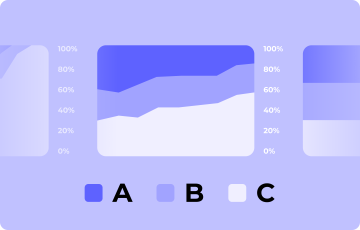
Hyperpersonalization: Power your CX optimization with AI
Personalization is time-consuming and requires a large amount of data to find the best triggers and experiences for highly specific user segments. The more granular your segments, the more resources your experimentation team needs.
However, AI-personalization tools now allow organizations to constantly iterate their personalization while making use of all their available user data. When you combine artificial intelligence and personalization, it’s sometimes called “hyperpersonalization”—a next-generation strategy that gives specific customer segments the offers and experiences that are most likely to trigger the actions they want.
Hyperpersonalization uses advanced algorithms instead of simple rules to determine what digital experience a segmented user should have in order to achieve a goal, and exactly when and where that personalized experience should be triggered.
While every CX program should start with simple A/B tests, you will eventually need to scale your experimentation program to avoid diminishing returns on your CRO. The ability to scale ultimately depends on the amount of data you can process, apply to experiments, and mine for insights, which is why AI is so valuable.
Find out more about hyperpersonalization in the first half of this article and read on to see how you can start doing it with Kameleoon Predict—a unique, AI-driven tool that enables marketers to measure visitors’ purchase intentions and present individualized messages, content, and offers in real-time.
1 What is hyperpersonalization?
Hyperpersonalization uses artificial intelligence (AI) and real-time data to present the right content to the right customers at the right time. This capability allows you to predict what the customer wants to see so you can tailor your messaging and website structure to perform one-to-one marketing rather than one-to-few.
With hyperpersonalization, you can personalize more efficiently. Instead of setting up rules and running individual A/B tests, it enables a more predictive approach with real-time data to individualize each customer experience.
Essentially, hyperpersonalization reveals:
- Which segment of visitors are at the brim of purchasing
- Which segment of visitors need to be nurtured
- Which segment of visitors have no intention of purchasing
- Which segment of visitors should be introduced to a specific action (like a purchase) to achieve a goal
This data allows individualized personalization to trigger actions that’ll most likely see a response—this could be customizing the homepage for a specific segment, pushing a discount coupon, or showing the “book a demo” button to the segment with the highest conversion propensity.
So, hyperpersonalization presents the right information to your customers according to their stage in the customer lifecycle and saves you the time and resources of a hit-and-trial approach. Ultimately, this allows you to focus on maximizing conversions and specific KPIs to help you reach your goals faster.
2 Personalization vs. hyperpersonalization
Personalization uses goal-oriented yet surface-level customer data like name, location, gender, buying capacity, and other demographic information to drive actions that tailor the customer experience to their needs. You have to set and test these rules manually.
Hyperpersonalization goes a step further by using artificial intelligence to understand and analyze behavioral data in real-time to predict what customers want to see by suggesting potential triggers that can cause them to take the desired action.
Algorithms—like the Kameleoon Conversion Score (KCS)—use filters like the number of views, prices, geolocation, product API, product pages, and journey targeting to tailor messaging and experiences. Thus, hyperpersonalization is more evolved and complex because it leverages customer behavior and browsing data.
Let’s say you’re a clothing website that wants to show the new range of winter puffer jackets to customers who have purchased them before. You already have some triggers in mind that will potentially push the customers to the purchase, like:
- Discount coupons for customers who always purchase when there’s a sale
- Additional recommendations for customers who often engage in impulse buying
- Different offers based on customers’ preferred payment method
While manual personalization can set these triggers and segments, hyperpersonalization will let you test all of these complex segments and experiences at scale to give you the best way to target them.
Hyperpersonalization follows a more dynamic approach with traffic allocation and algorithms to increase the efficacy of different experiences and triggers in real-time—which is also why it’s more complex and a step ahead of regular personalization.
3 Is your organization ready for hyperpersonalization?
You need to have an experimentation program in place before attempting hyperpersonalization.
But other signs may indicate your organization and marketing team are ready to conduct AI-based personalization:
- You have a good number of conversions to your main KPIs—this can be purchases, referrals, ROI, and subscriptions
- You get at least 1,000 conversions every month*
- Your marketing team already has a segment-approach strategy for A/B testing, and now they want to be more accurate with their targeting and predictions
If this doesn't apply to your organization, your best bet would be to troubleshoot your testing program and implement a more robust A/B testing sequence backed by a data governance strategy. Start small and work your way up the CX techniques pyramid.
On the flip side, if your organization has reached the point of scaling where your current testing efforts are not getting more qualified results and higher numbers as per your predictions—it’s time you leverage AI-based personalization.
You might wonder what you'll miss by not doing hyperpersonalization even though you need it? Let’s face it—it’s a more complex and expensive process than testing.
Suppose your current personalization program is reaching a point of diminishing returns in terms of uplift from your testing. In that case, hyperpersonalization is one way to increase the complexity of your experiments, which is highly correlated with more uplift. Solutions that come with AI personalization tools can also generate new customer insights automatically, as discussed in the section below.
*If you want to have robust propensity curves within 2 weeks, you should have traffic above 100,000 and a conversion rate on the KPI above 1%. You can still get a Conversion Score with less traffic of conversion, but it will take longer.
4 Benefits of hyperpersonalization
Hyperpersonalization is a predictive approach that makes data analysis faster and more accessible.
With hyperpersonalization, you can target highly specific segments of users, which AI builds based on your customer touchpoints in real-time.
Most businesses do not do any personalization because they see it as a complex and overly time-consuming process with no apparent benefits beyond what A/B testing already gives them. However, as CXL writes,
“This approach has two meaningful implications: first, as you change your marketing efforts, the right experience to show each visitor may very well change over time. With A/B testing, we’re all vulnerable to this realistic risk, and without frequent re-testing, it would be difficult to even know it’s happening. With predictive personalization, a machine keeps observing and adjusting to the then-current optimal experience. We’re future-proofed from our and our competitors’ changes to our marketing efforts.”
The benefits of being able to test many ideas at once, dynamically, are significant.
Increased revenue
Every marketing strategy aims to increase revenue, but with hyperpersonalization, you’re growing revenue by marketing to customers who have the highest propensity to convert or respond to your desired action.
Instead of marketing to a broad audience, AI personalization follows an individual approach to measure each visitor’s purchase intent and individualize messages and content for them. It does this by calculating a score to understand who you should focus on and what elements you should customize to make them convert.
These actions aim towards a collective marketing goal and larger business objective—to increase revenue. By following this predictive approach, hyperpersonalization pushes your customers to the purchase by showing them exactly what they need.
Improved customer experience and more loyalty
According to Adobe, 97% of business leaders believe customer experience management is crucial to creating loyal and long-lasting customer relationships. And there’s nothing better than creating authentic interactions with customers to show them what they need, so they keep coming back for more.
Since hyperpersonalization analyzes customers’ behavior constantly, segments it, and creates individualized messaging—customers go through unique browsing and shopping experiences. Each step of the customer journey addresses their expectations and needs by introducing them to relevant touchpoints that collectively point them towards the purchase.
Access to customer data and insights
An essential aspect of hyperpersonalization is making your marketing and sales team aware of your strategy. At least with Kameleoon, data obtained through AI tools is presented in a digestible format visually, so you can quickly collect insights about your users.
Being a predictive approach, it doesn’t give you a hard number but a score about the conversion potential of a customer and how they relate with your current goals and KPIs.
Since AI studies customer behavioral data to analyze patterns that help you personalize experiences, the data can also help improve other aspects of your business and strategy. For example, customer support teams can use it to understand how best to resolve customer issues.
5 How to do hyperpersonalization: A step-by-step guide
While traditional personalization is often done manually after running A/B tests, the crux of hyperpersonalization is AI, machine learning, and big data. A tool that enables CX experimentation like Kameleoon can do the heavy lifting for you, so you can just input your KPIs and audience details, get individualized data, and trigger actions to achieve goals.
Based on each visitor’s real-time onsite behaviors, Kameleoon’s AI algorithms allow marketers to predict the propensity score of each user to convert a specific goal into opportunities and get customer data to run segmented personalization triggers. Therefore, using Kameleoon, marketers can launch one-to-one campaigns to influence each visitor towards better outcomes.
Let’s look at how you can perform hyperpersonalization through Kameleoon Predict:
Step 1: Select one KPI (like login, purchase, or engagement) for machine learning activation. We recommend you get 100K visitors on your website to get accurate data in a short period of time.

Step 2: Look at the Kameleoon Conversion Score (KCS) to detect opportunities and choose who you want to target—i.e.cold or hot visitors— depending on your use case. Here you’ll see propensity scores that not only change in real-time, but also tell you who you should target and where the opportunity lies.

Step 3: Create a new segment using the opportunity by creating buckets of similar visitors to target them for a specific use case.

Step 4: Take the campaign live. It will then take 2-4 weeks for you to get accurate results with machine learning.

Step 5: Analyze your campaign results, just like you would do for A/B testing. These results will show you KPIs for people exposed to hyperpersonalization vs. those who weren’t to display the predictive impact of your efforts.
6 Hyperpersonalization: Not a magic button
AI is not a plug-in-and-go easy button for teams without CX optimization experience. Instead, AI can help you scale your personalization efforts and make testing and optimization more efficient, as well as running tests constantly.
Hyperpersonalization can help you improve your customers’ shopping experience by customizing it according to their needs and requirements. It can help you go beyond A/B testing and increase the complexity and variety of data you apply to your CX experiments.
If you’re ready to scale, use Kameleoon to kickstart your hyperpersonalization efforts. Manage your customers’ needs the right way by presenting them the correct information through your website to supercharge conversions and other crucial KPIs. Request a demo today.


